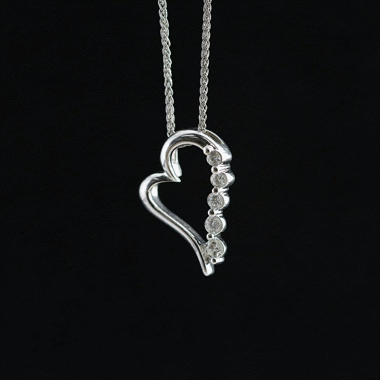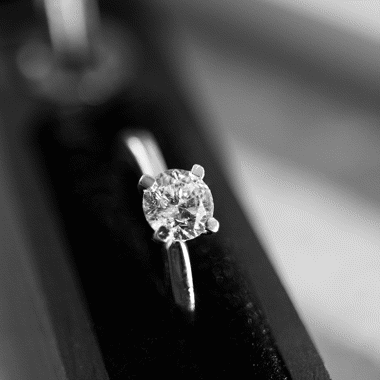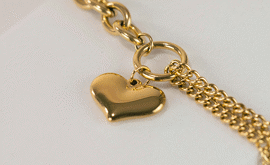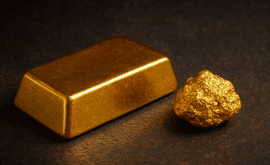What Is White Gold? A Complete Guide
What is white gold?
White gold is a precious metal alloy which is made by combing pure yellow gold with white-coloured metals like silver, palladium, or nickel. It is also often coated in rhodium to give it a bright, silvery finish.
How is white gold made?
Pure gold is a naturally a yellow colour, so to make it white it needs to be alloyed with white metals such as palladium, silver, or nickel. This process begins by melting down the pure yellow gold and the white alloy and mixing them together, with the ratio of yellow gold to white metal depending on the desired shade of white gold. The metal mixture is then poured into a mould to create the required shape, and then is cooled before being removed and polished. The white gold piece is then plated in a thin layer of rhodium, to enhance the durability of the item, and give it more of a bright white appearance. This plating can last for several years until it begins to wear and is needed to be reapplied by a professional goldsmith.
What is white gold made from?
White gold is made from a combination of pure yellow gold which is alloyed with white metals. The metals that are commonly used to form the white gold alloys are silver, palladium, or platinum. Nickel is also sometimes used, but this is often avoided as many people are allergic to the metal.
There is no universal definition or recipe for white gold, it can vary between goldsmiths with most of them having their own composition.
Why doesn’t white gold stay white?
The natural colour of white gold is off-white, with the bright white colour being achieved by the rhodium plating. This plating does wear over time, especially if the piece is heavily used, meaning the white gold will appear to discolour, showing a yellowish tint, so it needs a fresh recoat of rhodium every few years to keep its bright white sheen.
How can you tell if white gold is real?
The best way to confirm that a white gold piece is genuine is to check for a hallmark. In the UK, white gold weighing one gram or more must have a stamp engraved on the piece, which is the quality seal that gives your assurance of the quality of the metal. These markings are usually found on discreet parts of the item, such as the inside of a ring band, the clasp of chain, or on the back of an earring.
As white gold is alloyed with other metals, it cannot be pure gold so will not feature a 999 hallmark. Instead, white gold jewellery will most likely feature one of the following hallmarks:
- 375 - 9 carat gold (37.5% purity)
- 585 - 14 carat gold (58.5% purity)
- 750 – 18 carat gold (75% purity)
It is important to note that the rhodium plating applied to the white gold piece will not affect the gold content, as it is only a light layer added to enhance the white finish. If there is no hallmark present, professional testing (such as XRF analysis) may be needed to verify the piece’s authenticity.
How does white gold compare to platinum and silver?
White gold, platinum, and silver look similar, but they all differ in composition, durability, and value.
- Composition and colour: White gold is an alloy of pure gold mixed together with white metals and is coated in rhodium to make it a bright white colour. Platinum is a naturally white metal that does not require plating as it retains its colour over time, while silver has a natural white shine but, unlike white gold and platinum, can be prone to tarnishing.
- Durability: Platinum is extremely durable and can maintain its appearance with a minimal amount of maintenance, which can make it ideal for everyday pieces. White gold is strong and durable due to its alloy mix but will require rhodium re-plating over time. Silver is softer and more likely to scratch or bend.
- Value: Platinum is the most valuable of these three metals, due to its rarity and density. White gold’s value is also high and is based on its pure gold content. Silver is the most affordable option but does not have the durability and resilience of gold or platinum.
What are the pros and cons of white gold?
Like all precious metals, white gold has both strengths and drawbacks that may be worth considering before purchasing:
Advantages:
- Modern, elegant look with a bright white silvery finish.
- Strong, durable, and suitable for daily wear.
- Compliments both diamonds and coloured gemstones.
- More affordable than platinum.
Disadvantages:
- Rhodium plating needs reapplication every few years.
- Some alloys may contain nickel which can cause skin irritation in some wearers.
What is the history behind white gold?
White gold is believed to have been first used in the early 19th century because a more affordable alternative to platinum was required. Jewellers experimented with a variety of alloys, including mixing gold with other white metals – ultimately creating white gold.
White gold had a surge in popularity during World War II due to the US government confiscating all platinum for use in weapons and aircraft engines, forcing jewellers to offer white gold as an alternative option. The precious metal then remained popular after the end of the war due to its ease of wear and affordability and has continued to be widely used in engagement rings and other fine jewellery items today.
What is the price of white gold?
The price of white gold mainly depends on its fine gold content, which is measured in carats. For example, 18ct white gold contains 75% pure gold – the same as 18ct yellow gold, making its base value essentially the same.
The price of a piece of white gold jewellery can vary depending on a range of factors which include craftsmanship, rhodium plating, and brand or designer. This differs to gold bullion, which is almost wholly dependent on the live gold market price.
Does white gold hold its value?
Yes, white gold holds its value because it contains pure gold, a precious metal with intrinsic worth that has historically maintained and risen in value over time. Like yellow or rose gold, its price is determined by its purity measured in carats – the higher the carat rating, the higher the value.
Although white gold’s base value comes from its gold content, its price as a jewellery piece can also reflect factors such as craftsmanship and brand.
How should you care for white gold jewellery?
White gold jewellery needs careful handling, gentle cleaning, and regular re-plating to preserve its condition and bright appearance. Exposure to chemicals such as household cleaners, perfumes, sprays, and lotions can cause the plating to wear quickly, so it is always a good idea to remove jewellery before applying products or cleaning. White gold should also be taken off before swimming or bathing as chlorinated or soapy water can damage the finish of the jewellery. When not being worn, white gold jewellery pieces should be stored separately in a soft-line box or pouch to prevent any scratches.
Regular gentle cleaning of white gold jewellery can help to preserve its bright shiny appearance, using a mild dish soap and warm water solution together with a soft-bristled brush (like a baby toothbrush) to remove any dirt or residue. Harsh chemicals or abrasive materials should be avoided as these can damage the rhodium plating.
Over time, the rhodium plating on white gold jewellery naturally wears away, to reveal the yellowish tone of the gold alloy beneath. To maintain its silvery-white appearance, most jewellers recommend having white gold jewellery professionally re-plated every few years. However, the time needed between re-plating can depend on how often the jewellery is worn. This care routine ensures that your white gold can retain its shine and durability for many years.
This blog represents one person’s opinion only. Please note, gold and silver prices may go down as well as up. Atkinsons Bullion & Coins accepts no responsibility for any losses based on information we have provided. We do not offer investment advice. Please carry out your own research before making an investment decision.














